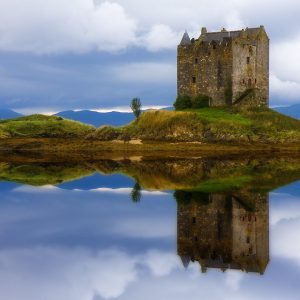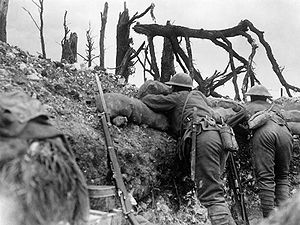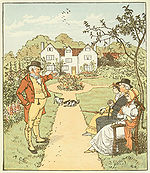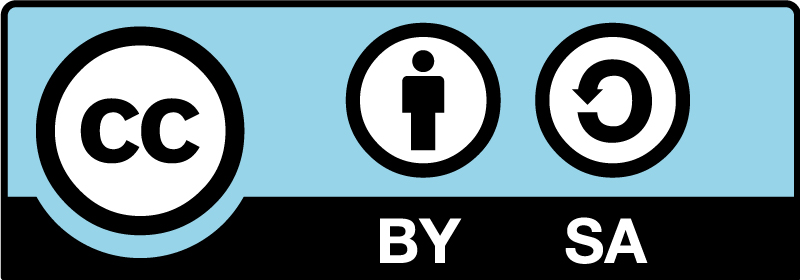- Overview
- Creative Commons Images
- Online Image Databases
- Websites
- Print and Electronic Publications
- Licensed Image Databases
Overview
The Copyright Act does not specify any citation requirements beyond the source of the material used and, if available, the name of the creator (ie:Creator, Source). While there is no legal requirement to attribute works in the public domain to their creator(s), doing so is an important part of maintaining academic integrity. Generally, image citations should meet the same requirements as a text citation; that is, a reader should be able to find the source of the image, and the image itself, based on the information in the citation.
If permission to use the image is obtained from the copyright holder, the copyright holder may require a particular citation style or that certain information be included. Examples of where permission requirements go beyond the basic copyright requirements are licensed library databases, creative commons licenses, and individual use agreements.
Below are image citation examples based on the minimum requirements of the Copyright Act and some common citation styles. Please refer to the citation practices of your discipline for more specific details. Include the citation as close to the image as possible, within the limitations of the medium.
Creative Commons Images
Creative Commons licenses are a suite of different licenses that facilitate the sharing and reuse of information and creative works. There are many different Creative Commons licenses and each allows the work to be shared and reused in different ways. Not all images available under Creative Commons licenses are available for all uses. For more information on Creative Commons licenses please visit the Creative Commons Wiki FAQ page or University of Leicester Library’s Presentation: Getting unCommonlyCreative: Reusing and creating open materials.
All Creative Commons (CC) licences require the image user to attribute the creator of the image, but how that attribution can be provided is flexible depending on the type of licence and the medium in which the image is being used. Depending on where the image will be used different citation formats are necessary to convey all the required information. In an online environment hyperlinks can be used to minimize the length of the image citation; in a print resource the citation will be longer because all the required information must be written out in full.
All CC attributions should have the same basic information:
- Title of image
- Creator name
- Source of the image (usually in the form of a URL to image source page)
- Any copyright information included with image (such as a watermark)
- CC licence information (including link back to CC documentation page if possible)
For a detailed guide to attributing creative commons material see: Attributing Creative Commons Materials created by CCI and Creative Commons Australia. For information on indicating third party content in CC materials, see Smartcopying’s guide: How to Label Third Party Content in Creative Commons Licensed Material.
Examples
| Example Image | Details |
|---|---|
 |
|
 caption: Castle Stalker © Andrea Mucelli, CC BY-NC-SA 2.0 |
Short, hyperlinked attribution statement. Castle Stalker © Andrea Mucelli, CC BY-NC-SA 2.0 |
 caption: Castle Stalker © Andrea Mucelli, used under Creative Commons Attribution-NonCommercial-ShareAlike 2.0 Generic |
Full, hyperlinked attribution statement. Castle Stalker © Andrea Mucelli, used under Creative Commons Attribution-NonCommercial-ShareAlike 2.0 Generic |
 caption: Castle Stalker (c)Andrea Mucelli (http://www.flickr.com/photos/bluestardrop/3859908007/ ). CC BY-NC-SA 2.0 |
Short, text only attribution statement. Castle Stalker © Andrea Mucelli (http://www.flickr.com/photos/bluestardrop/3859908007/). CC BY-NC-SA 2.0 |
| Full, text only attribution statement. Castle Stalker by Andrea Mucelli, retrieved from http://www.flickr.com/photos/bluestardrop/3859908007/. Used under Creative Commons Attribution-NonCommercial-ShareAlike 2.0 Generic license (http://creativecommons.org/licenses/by-nc-sa/2.0/) |
Online Image Databases
Online image databases are sites such as Flickr, Wikimedia Commons, or Getty Images. Some of them are free to use (Flickr) and some are commercial (Getty). The attribution or citation required depends on the individual database. Each database should have a terms of use or copyright statement laying out what is and is not permissible to do with the images in their collection and how the images should be attributed.
Databases with Creative Commons Licenses
Many of the free databases, like Flickr and Wikimedia Commons, use Creative Commons (CC) licenses to make the images available for reuse. In some cases, all images uploaded to the database are available under the same CC license; in other cases, it is up to the creator/ uploader to specify which type of CC license will be applied to each image. It is the creator, not the database owner, who retains copyright to the image. If you are using an image with a CC license from an online database, follow the attribution requirements specified by the CC license and the image creator. (See the Creative Commons Images section of this guide for more information on citing CC images.)
Databases with individual licenses or permission statements
If the database does not use creative commons licenses but the images are still available for free, check the terms of use (or copyright/permissions) section of the database for citation requirements. If there are no citation requirements specified by the database then the general rule of “creator, title, source” applies. In this case, the URL to the database site or the individual image page would be the best way to attribute source, although just the name of the datadase (ie: Flickr) would be sufficient for Copyright Act standards. Reference style guides, such as APA, MLA, or AMA, may have more detailed citation requirements; consult the appropriate style guide if you are following a particular style in your work.
Example of a database with a specific license and attribution requirements:
The Imperial War Museum (www.iwm.org.uk) makes most of their digital collection freely available for non-commercial uses. Under their Non-Commercial Licence it states that image users must
-
- “acknowledge the source of the Information by including any attribution statements specified by IWM and any other third parties (© ……) and where possible, provide a link to this licence.”
On the details page for each image it is specified if the image is available under the IWM Non-Commercial Licence and specifies the image citation:
-
- “By downloading any images or embedding any media, you agree to the terms and conditions of the IWM Non Commercial Licence, including your use of the attribution statement specified by IWM. For this item, that is: © IWM (Q 1069)”

caption: © IWM (Q 1069)
- “By downloading any images or embedding any media, you agree to the terms and conditions of the IWM Non Commercial Licence, including your use of the attribution statement specified by IWM. For this item, that is: © IWM (Q 1069)”
Websites
Citing images from a website is very similar to citing images form online image databases. Check the website’s terms of use (or copyright/ permissions section) to determine if the image is available for use and for any specific attribution requirements. If no specific attribution requirements are indicated then the standard “creator, title, source” (with the source being a URL to the image webpage) applies.
Note: Many websites and blogs use others’ materials without permission. When considering using an image from a website, double check the website owner is the copyright holder, or has permission to use and share that image. It is not always easy to identify who is the true copyright holder of an image so use your judgment. Is it reasonable to assume the website owner is the image copyright owner?
Print and Electronic Publications
A citation for an image from a published source requires, at minimum, the creator of the image and the source of the image. It is good practice to also include the image title. The general format would be:
-
- Creator, Title, source.
How the source of the image is cited depends on the citation practices of the discipline. For example citing an image from a journal source, formatted in APA style would look like this:
-
- Creator (Last name, First name), Title. From Author. (Date of publication). Article title. Journal Title, volume number(issue number), pages.
Formatted in MLA style it would look like this:
-
- Creator (first name last name), Title. From Author(s). “Title of Article.” Title of Journal VolumeIssue. (Year): pages. Medium of publication.
Examples (APA Style):
Short Citations
If including the full reference directly under the image is not appropriate for the project it is possible to include a short attribution under the image with a full citation or attribution statement in a reference page at the end of the work or in a footnote, much like an in-text citation.
| Example | Short Citation | Full reference |
|---|---|---|
 caption: Clusters B6OH12 and B228H24 (c) G. Forte et al, 2009. |
© G. Forte et al, 2009 | Image: Clusters B6OH12 and B228H24 G. Forte et al, Figure 1. From Forte, G. et al. (2009) Ab Initio Prediction of Boron Compounds Arising from Borozene: Structural and Electronic Properties. Nanoscale Research Letters, 5:158-163 Retrieved March 27, 2012 from SpringerOpen. doi:10.1007/s11671-009-9458-8 Used with permission from SpringerOpen. |
Licensed Image Databases
Licensed image databases are very similar to online image databases in that it is a license (or terms of use agreement) that gives users the permission to make use of the images. In the case of Library licensed databases though, the database license is usually much more complicated than the standard Creative Commons license. Please consult the library’s Licensing Database for specific licensing information on individual resources. Sometimes the license may stipulate images are to be cited in a particular way, or that the citation contain certain information. Generally though, a standard citation will be sufficient.
At a minimum, the image citation should include: Creator, Image title: Source. Many publication style manuals, including APA and MLA, have more specific and detailed requirements for citing images from digital databases. Some style guides make a distinction between images that are copies of physical art and images that exist only in a digital format. Refer to the citation practices specific to your discipline if you are following a particular citation style. Below are a few examples of APA and MLA style (adapted from SFU: Finding and Using Online Images).
Examples:
Minimum Citation:
-
-
-
- Creator, Title: Source.
- Edouard Manet, A Bar at the Folies-Bergere: ARTstor Digital Library
-
-
APA Citation:
-
-
-
- Creator last name, First initial. (Role of creator)(Date of creation) Title of image. [Type of work]. Retrieved from database name.
- Manet, E. (Painter) (1882) A Bar at the Folies-Bergere. [Image of Painting]. Retrieved from ARTstor Digital Library.
-
-
MLA Citation:
-
-
- Digital copy of an item in a physical collection:
- Creator’s last name, first name. Title of image. Year of creation. Physical collection. Title of database. Medium of access (Web). Date of access.
- Manet, Edourard. A Bar at the Folies-Bergere. 1882. Courtauld Institute Galleries, London. ARTstor Digital Library. Web. 10 April 2012.
- Digital image only:
- Creator’s last name, first name. Title of image. Year of creation. Title of website or database. Database publisher (if available). Medium of access (Web). Date of access.
- Towell, Larry. Ann Towell Watching Business Fax. 1995. ARTstor Digital Library. ARTstor Inc. Web. 10 April 2012.
- Digital copy of an item in a physical collection:
-

